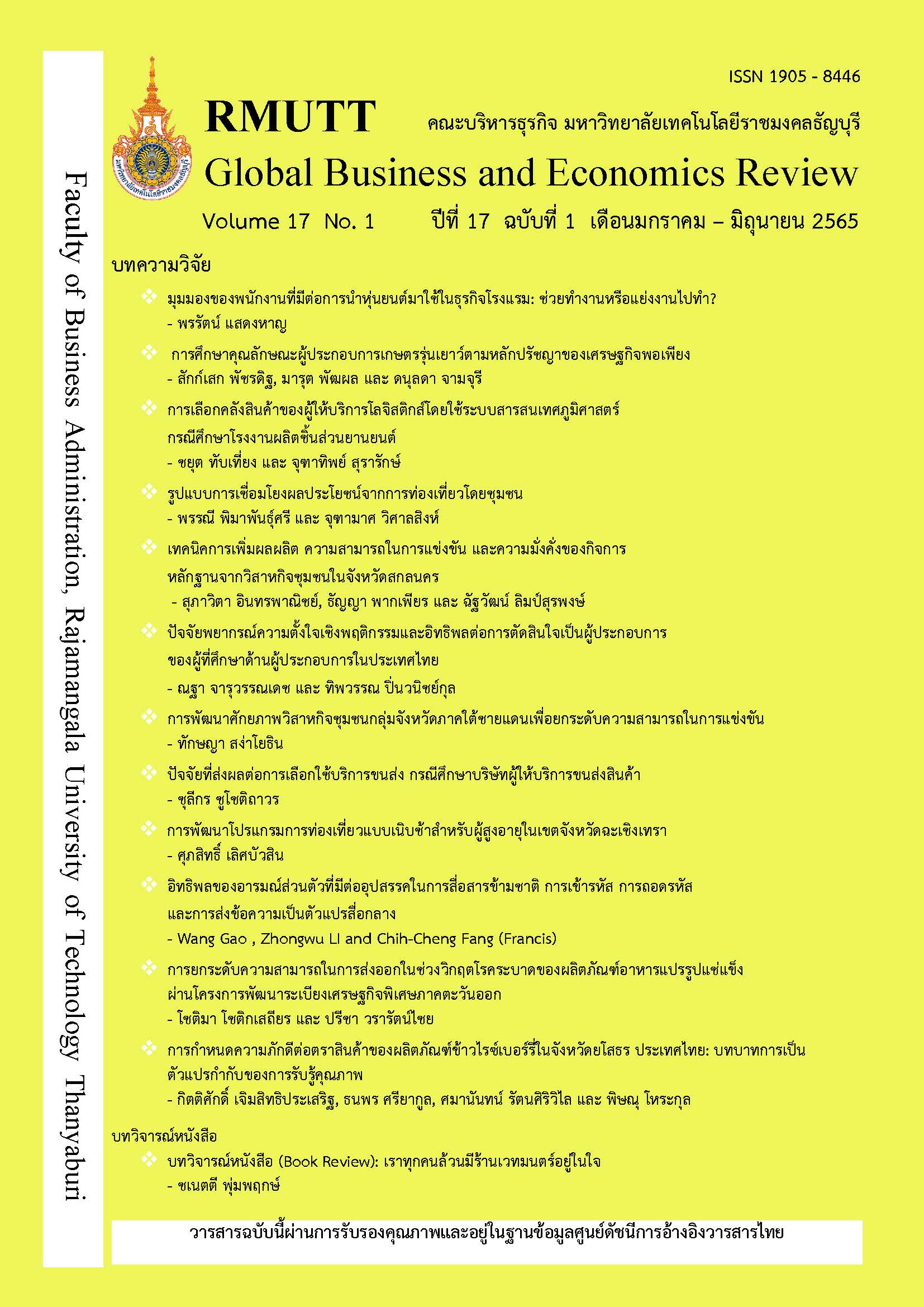THE DEVELOPMENT OF SLOW TOURISM PROGRAMS FOR ELDERLY TOURIST IN CHACHOENGSAO
Keywords:
Slow Tourism, Elderly Tourists, TouristAbstract
The research objectives are 1) to explore suitable tourist spots, 2) to study tourists' behavior and develop slow tourism programs for elderly tourists. This research is the quantitative method by distributing questionnaire with 385 Thai elderly tourists equal to and over 60 years by convenience sampling. The data analysis is descriptive statistics as frequency, percentage, mean, and standard deviation, and inferential statistics as independent sample t-test, ANOVA F-test. The results illustrate that from observing 47 places of attraction in Chachoengsao, there were 24 places which can be the destinations for elder tourists. Hypothesis solving stated that the suitable programs for elderly tourist were religious place which can offer for all genders and ages. Agricultural places can be offered in travelling route for all genders but suitable for tourists whose age between 60-75 years old. Medical places can be offered in the route as well for all genders but suitable for tourists whose age between 76-80 years old. Female tourists were interested in historical places more than male tourists and it should be offered to tourists whose age between 65-70 years old and 71-80 years old. Natural places had more desire for female than male tourist and it should be offered for tourists whose age between 71-80 years old.
References
กมลพร มูลอามาตย์. (2556). การศึกษาพฤติกรรมการท่องเที่ยวสถานที่ท่องเที่ยวเชิงศาสนาของผู้สูงอายุในจังหวัดขอนแก่น. (วิทยานิพนธ์ปริญญามหาบัณฑิต, มหาวิทยาลัยขอนแก่น).
กรมการท่องเที่ยว. (2555). การบริการนักท่องเที่ยวกลุ่มคนพิการ ผู้สูงอายุและครอบครัวที่มีเด็กเล็กและสตรีมีครรภ์. สืบค้นจาก http://www.tourism.go.th/assets/portals/1/news/839/1.pdf
การท่องเที่ยวแห่งประเทศไทย. (2560). รายงานประจำปี 2560. สืบค้นจาก https://www.tourismthailand.org/fileadmin/downloads/TAT_ANNUAL_REPORT/TAT%202017%20Annual%20Report%20DoubleSideLow-Res.pdf
กุลวดี แกล้วกล้า. (2550). พฤติกรรมการท่องเที่ยวของข้าราชการเกษียณอายุ. กรุงเทพฯ: มหาวิทยาลัยมหิดล.
เกษรา เกิดมงคล. (2546). รูปแบบการดำเนินชีวิต การแสวงหาข้อมูลเพื่อการตัดสินใจท่องเที่ยวและพฤติกรรมการท่องเที่ยวของคนวัยทำงาน. (วิทยานิพนธ์ปริญญามหาบัณฑิต, จุฬาลงกรณ์มหาวิทยาลัย).
ข้าวทิพย์ อ่อนอรุณ. (2553). ปัจจัยที่มีผลต่อพฤติกรรมการท่องเที่ยวภายในประเทศของนักท่องเที่ยวผู้สูงอายุชาวไทย. (วิทยานิพนธ์ปริญญามหาบัณฑิต, มหาวิทยาลัยเกษตรศาสตร์).
ฉลองศรี พิมลสมพงศ์. (2546). การวางแผนและพัฒนาตลาดการท่องเที่ยว (พิมพ์ครั้งที่ 4). กรุงเทพฯ: มหาวิทยาลัยเกษตรศาสตร์.
ฉลองศรี พิมลสมพงศ์. (2548). การวางแผนและการพัฒนาตลาดการท่องเที่ยว. กรุงเทพฯ: มหาวิทยาลัยเกษตรศาสตร์.
ชลวิทย์ เจียรจิตต์. (2562). การพัฒนาการท่องเที่ยวทางวัฒนธรรมสำหรับผู้สูงอายุ. วารสาร มจร. สังคมศาสตร์ปริทรรศน์, 8(1), 193-203.
ปริญญา นาคปฐม และระชานนท์ ทวีผล. (2561). การพัฒนาคุณภาพงานบริการทางการท่องเที่ยวสำหรับกลุ่มนักท่องเที่ยวผู้สูงอายุ. วารสารบัณฑิตศึกษา มหาวิทยาลัยราชภัฏวไลยอลงกรณ์ในพระบรมราชูปถัมภ์, 12(1), 255-269.
วารัชต์ มัธยมบุรุษ. (2554). แนวทางการพัฒนาเส้นทางการท่องเที่ยวส้าหรับนักท่องเที่ยวผู้สูงอายุ กรณีศึกษาพื้นที่รอบการไฟฟ้าฝ่ายผลิตแม่เมาะ จังหวัดลำปาง. ใน รายงานการประชุมวิชาการ มหาวิทยาลัยขอนแก่น ประจำปี 2554; “การพัฒนาอนาคตชนบทไทย : ฐานรากที่มั่นคงเพื่อการพัฒนาประเทศอย่างยั่งยืน”27-29 มกราคม 2554 (น.189-193). ขอนแก่น: มหาวิทยาลัยขอนแก่น.
ศันสนีย์ กระจ่างโฉม, อาชว์บารมี มณีตระกูลทอง และเผชิญวาส ศรีชัย. (2562). แนวทางการพัฒนากิจกรรมการท่องเที่ยวสำหรับนักท่องเที่ยวผู้สูงอายุชาวต่างชาติในพื้นที่อารยธรรมล้านนา. วารสารวิชาการมหาวิทยาลัยหอการค้าไทย, 39(3), 79-90.
สุรชาติ สินวรณ์ และณัฐบดี วิริยาวัฒน์. (2558).แนวทางการออกแบบสิ่งอำนวยความสะดวกและสภาพแวดล้อมทางกายภาพเพื่อส่งเสริมการท่องเที่ยวสำหรับผู้สูงอายุและพิการ ตลาดน้ำตลิ่งชัน. วารสารวิจัย มสด., 11(3), 97-116.
หนังสือพิมพ์ข่าวสด. (6 กุมภาพันธ์ 2561). กระทรวงท่องเที่ยว ร่วมมือ อพท. ยกชั้นเมืองรองสรางรายได้กว่าหมื่นล้าน. สืบค้นจาก https://www.khaosod.co.th/economics/news_741622
Marketeer. (2563). นักท่องเที่ยวทั่วโลกต่ำสุดในรอบ 15 ปี. เข้าถึงได้จาก https://marketeeronline.co/archives/154017
Caffyn, A. (2012). Advocating and implementing slow tourism. In T.V. Singh (Ed.), Critical debates in tourism (pp. 373-379). Bristol: Channel View.
Cochran, W. (1997). Sampling. Techniques (3rd ed.). New York: Wiley.
Dickinson, J. E., Lumsdon, L, M., & Robbins, D. (2010). Slow travel: issues for tourism and climate change. Journal of Sustainable Tourism, 19(3), 281-300.
Gardner, N. (2009). A manifesto for slow travel. Hidden Europe Magazine, 25, 10-14.
Haub, C. (2011). World population aging: Clocks illustrate growth in population under age 5 and over age 65. Population Reference Bureau. Retrieved from http://www.prb.org.
McCabe, S. (2009). Who Needs a Holiday? Evaluating Social Tourism. Annals of Tourism Research, 36(4), 667-688.
Mengyang, S., & Furong, C. (2009). The researches on senior tourism security service criterions. Tourism Institute of Beijing Union University. P.R.: China.
Pearce, P. L. & Lee, U. I. (2005). Developing the Travel Career Approach to Tourist Motivation. Journal of Travel Research, 43(3), 226-237.
Schroder, A., & Wildmann, T. (2007). Demographic change and its impact on the travel industry: oldies-nothing but goldies? In R. Conrady, & M. Buck (Eds.). Trends and issues in global tourism 2007 (pp.3-17) Berlin Heidelberg: Springer.
Sedgley, D., Pritchard, A., & Morgan, N. (2001). Tourism and aging: a transformative research agenda. Annuals of Tourism Research, 32(2), 422-436.
Downloads
Published
How to Cite
Issue
Section
License
Copyright (c) 2022 ศุภสิทธิ์ เลิศบัวสิน

This work is licensed under a Creative Commons Attribution-NonCommercial-NoDerivatives 4.0 International License.
The articles published in this journal are the intellectual property of their respective authors.
The views and opinions expressed in each article are solely those of the individual authors and do not reflect the positions of Rajamangala University of Technology Thanyaburi or any of its faculty members. All components and content of each article are the sole responsibility of the respective authors. In the event of any errors, the authors shall bear full responsibility for their own work.








